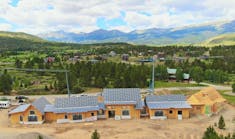Three US Patents Improve Strength and Sustainability of Infrastructure Materials
PISCATAWAY, N.J., September 19, 2016—The United States Patent and Trademark Office issued three patents to Solidia Technologies® for concrete production systems that offer the global construction and materials industries versatile, higher-performing and sustainable applications for infrastructure.
U.S. Patent No. 9,221,027, “Curing Systems for Materials that Consume Carbon Dioxide and Method of Use Thereof,” covers Solidia’s unique system that is used for curing materials that consume CO2.[1]
U.S. Patent No. 9,393,715, “Composite Railroad Ties and Methods of Production and Uses Thereof,” covers railroad ties (RRTs) manufactured from novel composite materials. Possessing physical and performance characteristics matching or exceeding traditional concrete, Solidia Concrete™ RRTs can be readily produced from widely available, low-cost raw materials by a process suitable for large-scale production with improved energy consumption, a more desirable carbon footprint and minimal environmental impact.[2]
U.S. Patent No. 9,266,147, “Precursors and Transport Methods for Hydrothermal Liquid Phase Sintering (HLPS),” provides a method for the CO2-curing of concrete at ambient pressure, without the need for an autoclave. This technology opens the door for the widespread production of Solidia Concrete.[3] Solidia Technologies shares this patent with Rutgers, The State University of New Jersey, where the original generation of the technology was co-invented by Vahit Atakan, Ph.D., Solidia’s Chief Scientist and former Rutgers graduate student and research associate, and Professor Richard (Rik) Riman, Ph.D., in his Material Sciences lab. Solidia has an exclusive licensing agreement with Rutgers for this technology.
“Our novel CO2-curing systems address an urgent need within the global US$1 trillion concrete and US$300 billion cement markets,” said Solidia President and CEO Tom Schuler. “We offer a profitable solution to the growing worldwide demand for durable infrastructure materials generated by increased globalization and industrialization.”
Combined, Solidia Cement™ and Concrete reduce carbon emissions up to 70% and recycle 60-80% of the water used in the production of concrete products, addressing the industry’s goal of reducing its carbon emissions, which contribute 3-5% of global CO2 pollution. “Producing materials that have tested to be stronger and more durable than traditional Portland cement products, our systems make it possible to be sustainable and profitable in an industry that needs to be both,” explained Schuler.
The U.S. Federal Highway Administration (FHWA) estimates that, in the U.S. alone, $170 billion in capital investment would be needed on an annual basis to significantly improve infrastructure conditions and performance. As part of its mandate to find solutions that are more resilient and sustainable, FHWA supports Solidia with a multi-year Cooperative Agreement (CRADA) to examine transportation infrastructure applications. This joint program includes independent testing of Solidia Concrete at the Turner-Fairbank Highway Research Center.
The Solidia Technology patent estate includes over 200 patent applications worldwide, with 31 issued patents and 15 scheduled to be issued within the next few months. Solidia’s investors include Kleiner Perkins Caufield & Byers, Bright Capital, BASF, BP, LafargeHolcim, Total Energy Ventures, Bill Joy and other private investors.




